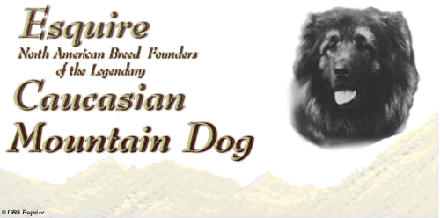

|
|
|

|
|
|
Adventures In Russia
by Stacey Grether Kubyn June, 1992. Never having traveled beyond U.S. borders, I'm a bit apprehensive to say the least as I'm boarding a plane bound for Russia. Elena, my friend and Club mentor, had invited me to visit her city, newly renamed St. Petersburg, to study the Caucasian Mountain Dog in its native surroundings. Imagine being whisked away, in a matter of a few short hours to another time, another life. Glorious St. Petersburg, brimming with beauty, history and culture, simultaneously exudes an overwhelming sense of grimness and despair. Decades of repression and recent economic and political turmoil have effaced the Russian smile. However, I was quickly embraced by the warmth and love of the people. Life here is very difficult - six families share a flat with one bathroom, aged ceilings of buildings in total disrepair crumble overhead, food and supply shortages the usual circumstance. Yet the Russian spirit continues to endure the many hardships. This trip made me appreciate how lucky we Americans have it in just about every aspect of our life, and how grateful I am to own and exhibit dogs with ease in the U.S. As one would expect to find anywhere, the dogs in Russia ranged in quality from excellent to poor. The native breeds - Caucasian Ovcharka, Central Asian Ovcharka, South Russian Ovcharka, Black Russian Terrier and Moscow Watchdog - appeared healthier and more robust than some other breeds especially of the non-sporting group. Commercial dog food and supplements are generally unavailable - pets are fed cooked meat and vegetables in the correct nutritional balance. Because many dog fanciers own small, apartment size refrigerators, storage of fresh meat and/or cooked food is difficult, and shopping and cooking for pets becomes an almost daily chore. Vaccines, too, are in short supply (and I was shocked that some breeders won't use vaccines even when they are available) and many dogs ravaged by illnesses such as distemper bear permanent damage. Generally, the dogs excelled in correct bite and dentition and had excellent pigmentation. Large size is in vogue - I saw some really "giant" collies - and most of the dogs are very well-boned. I was privileged to judge two shows, FCI style (Russian group designations) with written critique. I judged primarily Working Group (Rottweiler, German and East European Shepherd, Giant Schnauzer, and the native breeds already mentioned along with the balance of the other groups) toiling from 10:00 AM to 6:00 PM with over 70 dogs each show. Skilled handling was sorely lacking but the people were absolutely thrilled to have an American judging and were most eager to learn. I also passed along information to several dog clubs on dysplasia and other health concerns which was very well received. Some of the Caucasian Mountain Dogs (Ovcharkas) were magnificent with outstanding conformation, balanced temperaments, superb guarding ability and thorough training. I met many people dedicated to the preservation of the breed in its aboriginal form - to some it is nearly their whole life work. Fortunately for us, they have generously offered to help our Club establish the true breed in the U.S. (c)1992, 1997 Stacey Grether Kubyn Caucasian Ovcharka (Mountain Dog) Club of America U.S. Breed Founders For Preservation, Est. 1991 Author's Note: The above article refers to Russia as "native surroundings". The breed's actual *Native Regions* are the Caucasus Mountains and Steppe regions, south of Russia. |
|

|